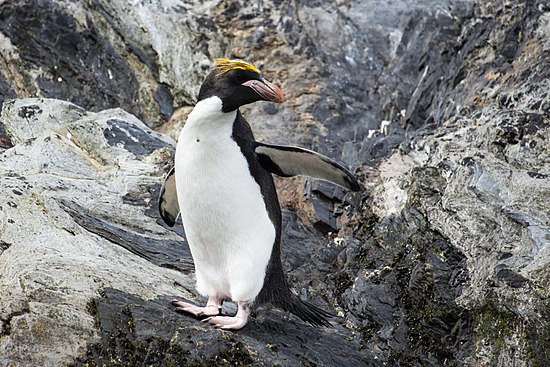| Macaroni penguin | |
|---|---|
| In Cooper Bay, South Georgia | |
| Scientific classification | |
| Domain: | Eukaryota |
| Kingdom: | Animalia |
| Phylum: | Chordata |
| Class: | Aves |
| Order: | Sphenisciformes |
| Family: | Spheniscidae |
| Genus: | Eudyptes |
| Species: | E. chrysolophus
|
| Binomial name | |
| Eudyptes chrysolophus (Brandt, 1837)
| |
| Macaroni penguin range Breeding colonies in red | |
| Synonyms | |
|
Catarractes chrysolophus Brandt, 1837[2] | |
The macaroni penguin (Eudyptes chrysolophus) is a species of penguin found from the Subantarctic to the Antarctic Peninsula. One of six species of crested penguin, it is very closely related to the royal penguin, and some authorities consider the two to be a single species. It bears a distinctive yellow crest on its forehead. Its face and upperparts are black and sharply delineated from the white underparts. Adults weigh on average 5.5 kg (12 lb) and are 70 cm (28 in) in length. The male and female are similar in appearance; the male is slightly larger and stronger with a relatively larger bill. Like all penguins, it is flightless, with a streamlined body and wings stiffened and flattened into flippers for a marine lifestyle.
Its diet consists of a variety of crustaceans, mainly krill, as well as small fish and cephalopods; the species consumes more marine life annually than any other species of seabird. These birds moult once a year, spending about three to four weeks ashore, before returning to the sea. Numbering up to 100,000 individuals, the breeding colonies of the macaroni penguin are among the largest and densest of all penguin species. After spending the summer breeding, penguins disperse into the oceans for six months; a 2009 study found that macaroni penguins from Kerguelen travelled over 10,000 km (6,200 mi) in the central Indian Ocean. With about 18 million individuals, the macaroni penguin is the most numerous penguin species. Widespread declines in populations have been recorded since the mid-1970s and their conservation status is classified as vulnerable.
- ^ BirdLife International (2020). "Eudyptes chrysolophus". IUCN Red List of Threatened Species. 2020: e.T22697793A184720991. doi:10.2305/IUCN.UK.2020-3.RLTS.T22697793A184720991.en. Retrieved 12 November 2021.
- ^ "Species Eudyptes chrysolophus (Brandt, 1837)". Australian Biological Resources Study: Australian Faunal Directory. Canberra, ACT: Department of the Environment, Water, Heritage and the Arts, Commonwealth of Australia. 9 October 2008. Archived from the original on 6 November 2012. Retrieved 25 March 2010.

